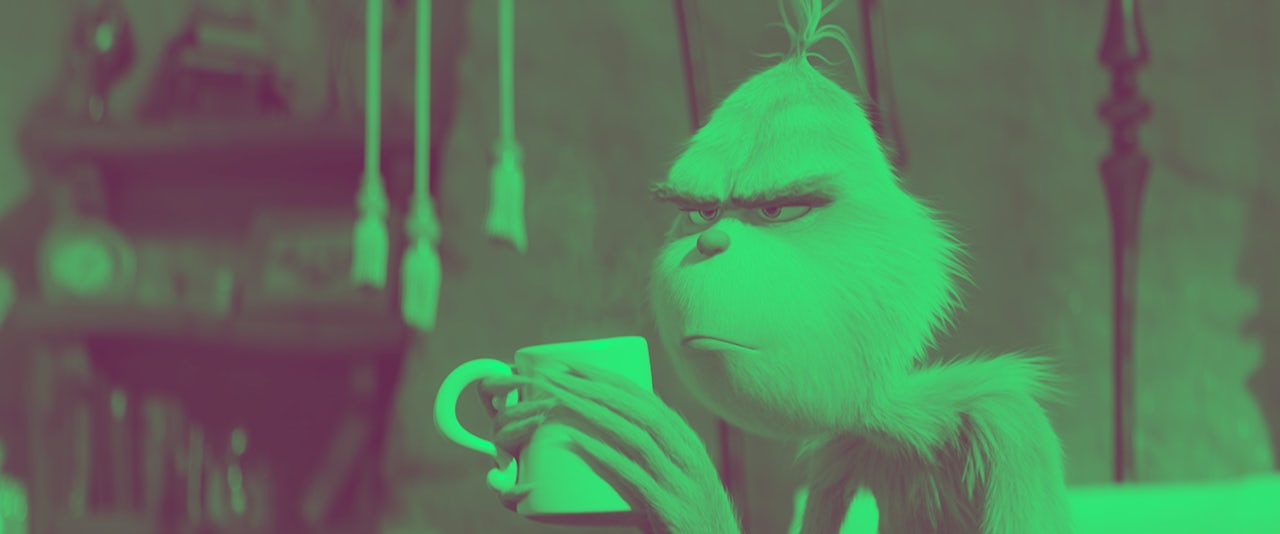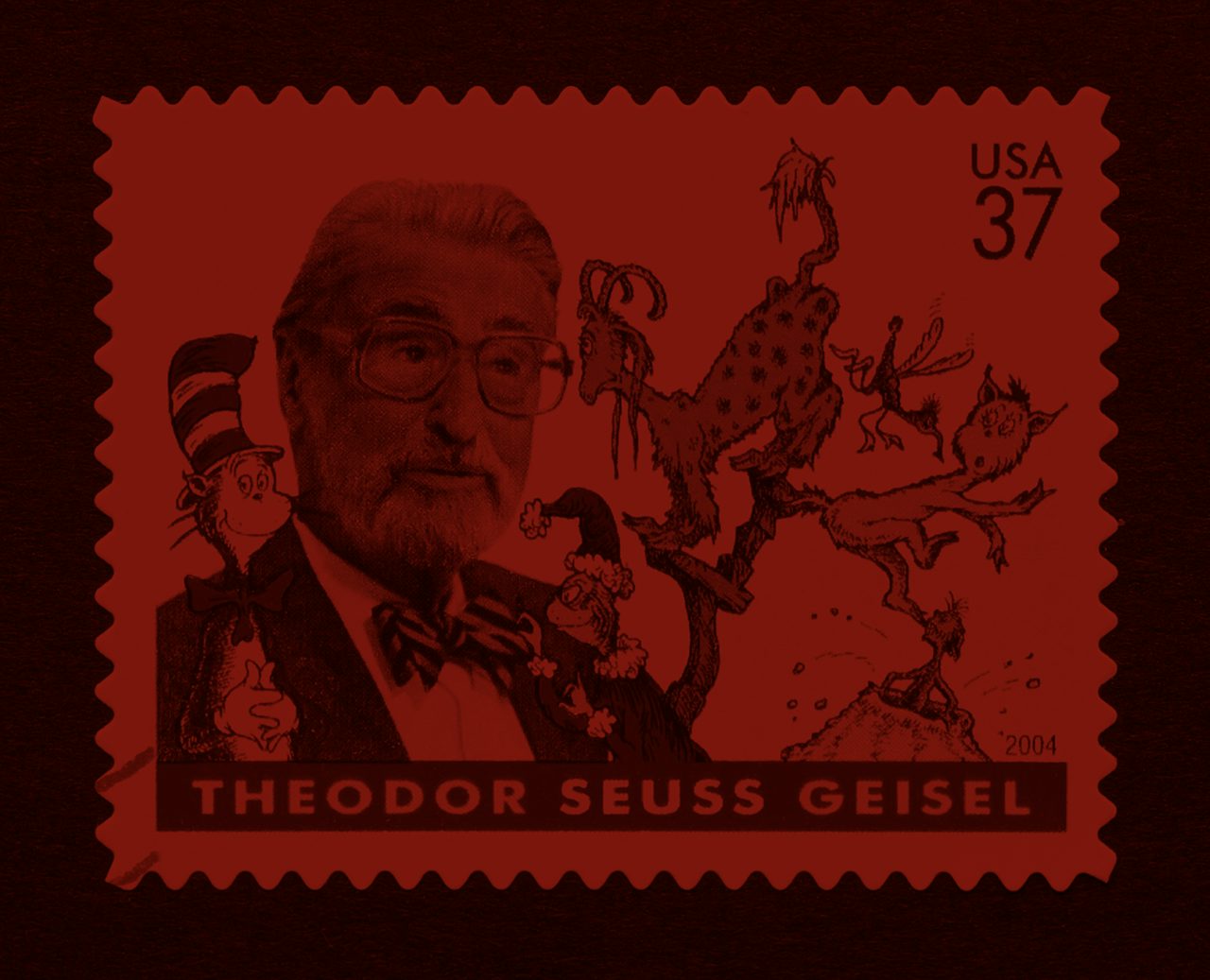Right before 2018’s The Grinch starts, its viewers must reckon with a Minion. Before you can get to Dr. Seuss’s famous character, several byzantine degrees removed from his source material, the little pill-shaped yellow creature turns on the Illumination Studios lights as part of a studio intro, and laughs maniacally. Someone, the diminutive hellbeast reminds you, is about to get insanely rich off of some very lazy art.
The road to such corporatization of a beloved children’s property is long, and paved with good intentions. In 1998, Seuss’s widow Audrey Geisel put his most valuable work up for auction to Hollywood. Perhaps because Seuss himself (real name Theodor Geisel) had always been so resistant to allow anyone’s hands but his own express the essence of his dear characters, her terms for studio biddings were severe: $5 million upfront, 4 percent of the box-office gross, 50 percent of the merchandising revenue and music-related material, and 70 percent of the income from book tie-ins.
Audrey Geisel also provided a short list of performers who she deemed worthy of starring in this work. Only the most famous, magnetic men would be allowed to play the lead: “any actor submitted for the Grinch must be of comparable stature to Jack Nicholson, Jim Carrey, Robin Williams and Dustin Hoffman,” her announcement stated. Carrey ended up winning the role in part by eschewing normal human behavior when he met Geisel, grabbing her and twirling her and doing a crazy impression of the Grinch, centimeters away from her face.
He acted, in other words, more like he was a cartoon than an actual person. His subsequent performance as the famous fuzzy green misanthropist frightened the shit out of many of the children and their parents who saw it. This wasn’t entirely Carrey’s fault; while financially successful, 2000’s Ron Howard-directed How the Grinch Stole Christmas is a document borne from a confused, complicated production founded on two really bad premises.
The first was that the essentially perfect 1966 Grinch TV special that Seuss made with animation legend Chuck Jones could be tastefully stretched from 26 minutes to 104. This effort included giving the titular character an overwrought origin story about how being made fun of for being hairy in grade school ruined his psyche, and also a bit where the deranged horny mayor of Whoville (Jeffrey Tambor) coerces a local hottie into marrying him, among other terrorizing side stories.
The second, more fear-inducing assumption of the film was that Seuss’s world should be made corporeal. The uncanny valley horrors of Carrey’s elaborate, priceless costume make the film difficult to watch. In a handful of drawn-out scenes, the Grinch speaks psychoanalytical soliloquies to himself in his grumpy lair, with rising manic energy, and in these moments you can watch in real time as the greed of Hollywood leans so far into a dream that it becomes a nightmare, rich with the unintentionally Lynchian and avant garde.
Twenty years later, the Seuss/Hollywood machine has been refined. The labor to make Seuss’s singular aesthetic into something believably tangible has ceased, not repeated since 2003’s dreadful The Cat in the Hat, a box office bomb that featured a Smash Mouth cover of The Beatles’ “Getting Better” and ends with Alec Baldwin covered in purple goop. The recently released The Grinch is the third in a line of slick, unambitious computer-animated Seuss adaptations for the theater. In 2008, 20th Century Fox released Horton Hears a Who!; in 2012, Illumination Studios, who has also brought the new Grinch to life, seemingly took over the Seuss line with The Lorax.
Benedict Cumberbatch stars as the voice of a Grinch whose love-allergic theft of Christmas comes in part because he was orphaned as a child, his desertion leading to his loathing of others’ happiness. This urge to give the Grinch’s disposition some roots in a traumatic formative event is the sort of hack narrative convention that Seuss himself was always able to avoid — both by telling much more (appropriately) shorter stories, and also through the sheer creative flexing of his language and imagery, which always moved in more adventurous directions. This movie’s sloppy need to understand the Grinch shows a level of empathy for shitty behavior that recalls the frustrations posed by the other-side-ism disease running through ludicrously humanizing newspaper profiles of people whose politics are to destroy other people. There is no other side to basic decency, and the real Grinch is not a tragic figure. He is an asshole who, while highly amusing, needs to get over himself and stop stealing peoples’ stuff.
In a voiceover narration by Pharrell Williams, we’re told the new Grinch has a heart two sizes too small, just like the original, but the movie isn’t comfortable letting this poetic description stand on its own. This Grinch, who is also fundamentally softer than he was back in 1966, has been failed by his parents. The old Grinch, a true inexplicable savage, had yellow eyes and crooked teeth, and was demonstrably abusive to his dog Max, who he whipped repeatedly while he was buried several feet deep in snow. Original Grinch even stole individual ice cubes and flower petals from Whoville homes on Christmas Eve. Depraved!
This new Grinch, who is pleasantly neon green and frankly well groomed, starts his story with a “depressing bean” for breakfast before going into town to mildly harass Whoville citizens on his grocery run. He tells Max he is “a good dog” and even tries to play music with him. He adopts a big fluffy moose as a potential reindeer, and lets him get into bed with him. He lets the moose go when he discovers that the moose has a loving family. At one point he throws a kid into a snowman, but, really, the Grinch is not so mean. One might wonder how he got his name. He is grumpy, sure, but his mean streak is shallow; he is more sassy than monstrous. He spends basically the whole movie on the precipice of breaking good.
“You find out more about why the Grinch is the way he is. Then you can enjoy his meanness,” Cumberbatch said of the new character. “We get insight into what makes him tick. So it is not just the villain without having some understanding of where it’s all coming from.” Audrey Geisel and family have reportedly signed off on reaching across the aisle to the Grinch in this way, for reasons we may never know.
Eventually, the Grinch is triggered when he uses a telescope to zoom in from his mountaintop onto the grand lit-up tree of Whoville. After a catapult mishap launches him into the tree, he comes face-to-face with collective joy in a way that re-hatches his classic plan to take holiday cheer away from the people. This happens about half an hour into a movie with a runtime of 79 minutes, a number which seems to include the credit sequence. For all its emptiness and artlessness (none of the aesthetics are properly Seussian here, only sporting the occasional obligatory curlicue), it is at least considerate of the film to get on with its harvesting of bountiful intellectual property with a certain efficiency.
There is no other side to basic decency, and the real Grinch is not a tragic figure. He is an asshole who, while highly amusing, needs to get over himself and stop stealing peoples’ stuff.
There is some awkwardness, really, in even calling The Grinch a movie. It is probably more accurately categorized as a branding exercise. Most peoples’ familiarity with the movie, to date, is by way of an advertising campaign that simply sports the new version of the character at train stations, accompanied by tepidly negging remarks, some of which are regionally specific. In Chicago, he says: “I’ve seen windier cities.” In New York City, he says: “No, I don’t want to go to your off-Broadway play.” Most people I’ve spoken to about these ads seemed unaware they were even attached to a movie. Maybe The Grinch is part of a new cell phone plan? There is a Grinch app now, perhaps? Promotion for the movie also includes ads where the Grinch calls and teases NBA stars J.R. Smith and Draymond Green.
The failed familiarity and grandiosity of this P.R. work is of a breed sublimely mocked in comedian Gabriel Gundacker’s meme-song “Zendaya is Meechee.” In the song, Gundacker sarcastically performs reverence for the aggressively advertised characters of the computer-animated kids’ movie Smallfoot. The latest Grinch is not an original work in the vein of that release, but it comes to us through the same insidious pipeline. The idea that anyone is super excited about its unnecessary existence — made possible by a weird cast of collaborators including Cumberbatch, Pharrell, Kenan Thompson, Rashida Jones, Tyler the Creator, Danny Elfman, and the producers of Snow Dogs and You, Me and Dupree, all transparently here to get the bag — is so alien that to live it out is hilarious.
I don't like this new grinch pic.twitter.com/Dl7VtQxVB1
— Bug Mane🐛 (@bugmanetv) October 20, 2018
The best the movie can do for its audience is mild stimulation. In the case of children and busy parents who can’t stay at the theater for too long, this is probably fine. As the viral excavation of Johnny Johnny Yes Papa tells us, moving shapes and figures is really all it takes for most kids. If I was 5, I would probably like this movie. But it misunderstands the moral imagination and visual wonders of its source material, its singular sense of character and music and prosody. The 1966 TV special was a jolt to the existing Christmas lexicon. Seuss’s infectiously nonsensical world-making was of an enduring weirdness that has been watered down here, just as his main character’s cruelty has. 2018’s Grinch is a hodgepodge product that sees the iconic hater in bright pink pants that say “GO TIME” on his ass while he also wears flip flops, does “emotional eating” of heaping piles of spaghetti, and encounters a screaming goat. During one of the side stories, a naked child holds a chocolate chip cookie over his dick to maintain decency.
But despite often displaying the same kind of colorful ADHD nonsense of a movie where Adam Sandler voices a digitally drawn Dracula, The Grinch remains relatively faithful to the nascent tale. It could’ve been worse. In 2012’s The Lorax, the original Seuss story is complete with half an hour to spare, and the rest of the movie is about a high-speed car chase in which Rob Riggle goes after Taylor Swift, Zac Efron, and Betty White as they try to plant the world’s last tree in an enclosed city.
Nothing so egregious happens here. Some who go to The Grinch might, in fact, hope for a more spectacular failure, because what they will see instead is so anodyne and forgettable. There are moments when the sentimental power of the 1966 parable shines through, sure, but it’s still just a copy of a copy of a thing so good that we can’t stop making worse versions of it. Now that the Grinch has been co-opted into such bland franchising and feel-goodery, a new cantankerous creature must be invented to disrupt the festivities — another outsider with fresh zeal for busting up joy, someone Geisel’s original protagonist might have deemed a worthy comrade-in-hate.


